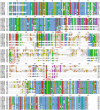Expression analysis of PIN family genes in Chinese hickory reveals their potential roles during grafting and salt stress
- PMID: 36247577
- PMCID: PMC9557188
- DOI: 10.3389/fpls.2022.999990
Expression analysis of PIN family genes in Chinese hickory reveals their potential roles during grafting and salt stress
Abstract
Grafting is an effective way to improve Chinese hickory while salt stress has caused great damage to the Chinese hickory industry. Grafting and salt stress have been regarded as the main abiotic stress types for Chinese hickory. However, how Chinese hickory responds to grafting and salt stress is less studied. Auxin has been proved to play an essential role in the stress response through its re-distribution regulation mediated by polar auxin transporters, including PIN-formed (PIN) proteins. In this study, the PIN gene family in Chinese hickory (CcPINs) was identified and structurally characterized for the first time. The expression profiles of the genes in response to grafting and salt stress were determined. A total of 11 CcPINs with the open reading frames (ORFs) of 1,026-1,983 bp were identified. Transient transformation in tobacco leaves demonstrated that CcPIN1a, CcPIN3, and CcPIN4 were localized in the plasma membrane. There were varying phylogenetic relationships between CcPINs and homologous genes in different species, but the closest relationships were with those in Carya illinoinensis and Juglans regia. Conserved N- and C-terminal transmembrane regions as well as sites controlling the functions of CcPINs were detected in CcPINs. Five types of cis-acting elements, including hormone- and stress-responsive elements, were detected on the promoters of CcPINs. CcPINs exhibited different expression profiles in different tissues, indicating their varied roles during growth and development. The 11 CcPINs responded differently to grafting and salt stress treatment. CcPIN1a might be involved in the regulation of the grafting process, while CcPIN1a and CcPIN8a were related to the regulation of salt stress in Chinese hickory. Our results will lay the foundation for understanding the potential regulatory functions of CcPIN genes during grafting and under salt stress treatment in Chinese hickory.
Keywords: Carya cathayensis; PIN; auxin; grafting; salt; transport.
Copyright © 2022 Yang, Mei, Chen, Yang, Gu, Tang, Lu, Yang, Sharma, Wang, Yan, Wu, Zheng and Yuan.
Conflict of interest statement
The authors declare that the research was conducted in the absence of any commercial or financial relationships that could be construed as a potential conflict of interest.
Figures









References
LinkOut - more resources
Full Text Sources

